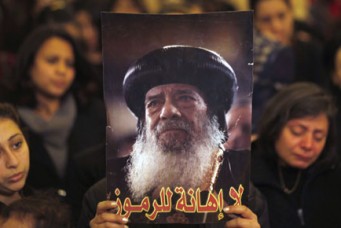Is the Government-Church Alliance a “Coptic Marriage”?
The Coptic Orthodox community occupies a paradoxical space in Egypt’s imagination; both Muslim and Christian religious elites insist that the Copts are no mere “minority,” but rather an integral component of the national fabric. Yet many Christians—especially working class and rural Copts—face documented and institutionalized discrimination. Over the last few decades, the church tried to manage these contradictions by monopolizing the community’s political expression within the papacy and its hierarchy—a monopoly made possible through the church’s close bonds with the Mubarak regime and its exhortation of adherents to refrain from dissent. But since Mubarak’s ouster, young Coptic activists have been working to fundamentally change the way the community engages politically.
The Coptic Orthodox community occupies a paradoxical space in Egypt’s imagination; both Muslim and Christian religious elites insist that the Copts are no mere “minority,” but rather an integral component of the national fabric. Yet many Christians—especially working class and rural Copts—face documented and institutionalized discrimination. Over the last few decades, the church tried to manage these contradictions by monopolizing the community’s political expression within the papacy and its hierarchy—a monopoly made possible through the church’s close bonds with the Mubarak regime and its exhortation of adherents to refrain from dissent. But since Mubarak’s ouster, young Coptic activists have been working to fundamentally change the way the community engages politically.
The alliance between church and regime was not easily forged. Immediately before Mubarak’s rise to power in 1981, the previous president, Anwar Sadat, placed Pope Shenouda under house arrest as punishment for mobilizing Coptic sentiment against him. Only in 1985—when Mubarak “pardoned” Shenouda—did the pope become a major supporter of Mubarak’s regime. Eager to foster the perception of interreligious harmony, Mubarak allowed for Coptic independence in community affairs and recognized Shenouda as the voice of the church in political matters. Shenouda and the bishops alone were allowed to petition the regime on a whole range of sensitive issues including sectarian violence, church construction, and family disputes. The pope was also consulted in appointing Coptic government officials and bureaucrats.
In return for this “protection” and autonomy, the hierarchy gave its support to the regime and aggressively began discouraging grassroots Coptic activists from independently applying pressure on the regime—even to the point of suspending politically active priests, such as Father Philopateer, a priest from the working-class district of Shubra who actively campaigned for the opposition party al-Ghad during the 2005 presidential election. Pope and president seemed to agree that Coptic issues were best addressed behind closed doors and among regime and church elites.
But the hierarchy’s monopoly on Coptic political activity eroded during the Mubarak regime’s last two years—largely as a result of an uptick in anti-Coptic violence in 2009. That year, young activists formed an independent political group known as “Copts for Egypt,” comprised of working-class Coptic youth. The group called for a general strike on the Coptic New Year, September 11, 2009, to protest both the regime’s unwillingness to curb sectarian violence and unfair laws governing church construction.
Although the strike failed to gain widespread support, the charge of regime complacency resonated with many in the community. The Mubarak regime’s inability to stabilize sectarian relations enough to prevent later violent incidents (like the 2010 shooting in Nag Hammadi and the 2011 bombing at the Alexandrian Church of the Two Saints) even convinced many Copts that the security apparatus was complicit in the violence. It didn’t help that after the Alexandria bombing, the church echoed the regime’s sound bites that the attack was the work of outside forces seeking to “destabilize the country.” Many in the community disapproved of the church’s anemic stand, and after the Alexandria Church bombing, activists with “Copts for Egypt” alongside independent Coptic demonstrators, chanted anti-Mubarak slogans in Cairo and Alexandria. The Pope spoke out publically against them and admonished them to soften their tone, as “the slogans used by some transgressed all values and modes of behavior.”
Church support for Mubarak continued throughout the 18-day uprising. It publicly opposed protests and, according to a number of activists, church officials privately ordered the faithful to stay home. According to Ramy Kamal, one of the organizers of “Copts for Egypt,” a number of church leaders appealed to him personally to keep his group out of Tahrir Square. On February 5th, in an interview with state television, Shenouda called for an “end to protests,” and reiterated his support for the Mubarak regime. These appeals were ignored; Kamal and other activists noted that although they hold the Pope in “high regard,” they did not consider him a political leader. “I will protest whenever I like. The pope is my spiritual leader, not a politician,” Kamal said.
The crisis of political authority ushered in by the fall of Mubarak (which genuinely surprised church leaders) opened new space for Coptic activists to operate outside of traditional hierarchies. Following the May 2011 burning of several Coptic churches in the Cairo neighborhood of Imbaba, Coptic activist groups (including “Copts for Egypt”) formed the “Maspero Youth Union,” representing the first major challenge to the church’s political hegemony since the uprising. Their message resonated with the legions of youth who felt that the aging church hierarchy was an ineffective aggregator of Coptic political interests, and within a month, the Union quickly opened offices throughout Egypt, including branches in Alexandria and Qena. The Union’s first act was to initiate a sit-in in front of the State Television building of Maspero to protest the government’s unwillingness to prevent violence against Copts.
Although the church did not initially oppose the sit-in, in early May Bishop Youannes, the Pope’s secretary, spoke privately with SCAF Major General Adel Emara in St. Mark’s Cathedral and arranged an end to the sit-in. According to activists, the church called on the Maspero Youth Union to return home and allow the bishops to negotiate a settlement with the SCAF behind closed doors. But, as many Union members distrusted Mubarak’s generals, the sit-in ended only when Prime Minister Essam Sharaf met privately with protesters themselves and assured them that new anti-discrimination laws would be enacted. The Union’s resistance to the church’s traditional political hegemony represented a new and direct challenge to the church hierarchy.
But as anti-Coptic violence escalated after Mubarak’s ouster, public Coptic protest became the norm. In October 2011, in response to the forced closing of a church in Upper Egypt, a coalition of Coptic activist groups (including the Maspero Youth Union) organized a march from the working-class district of Shubra to the Maspero television building. The march—now well documented by the media—resulted in the death of 27 demonstrators. But despite video evidence showing military vehicles running over peaceful protesters, the military denied any responsibility for the attack and blamed the demonstrators themselves for attacking soldiers, stealing trucks, and running over one another.
The Maspero incident offered the Coptic Church a legitimate opportunity to break with the SCAF, but church leaders refused to hold the army “directly responsible” for the violence and instead pointing to “infiltrators.” This refusal—in the face of irrefutable evidence—enraged many in the community, and brought Coptic activism to fever pitch. When the pope invited military generals to the Cathedral to celebrate Christmas Mass, demonstrators interrupted the proceedings with chants of “Down with Military Rule.” On February 11th, the Union of Maspero Youth directly defied the pope’s public statements and participated in a general strike calling for the SCAF to step down. Before the parliamentary elections, Coptic activist Michael Mounir (who had been critical of the church’s refusal to back the Tahrir protests) founded Haya, a political party specifically geared towards Copts. Although the party failed to win seats, its formation represents a significant defiance to the Church’slongstanding opposition to Coptic political parties.
Above all, Maspero demonstrated that, even in the face of explicit violence, the church’s hierarchy is not yet willing to break with the SCAF. Many bishops are jockeying to replace the aging Shenouda (rumored to be very ill), and few would risk losing the military’s support in a future bid for the papacy.
But the church is underestimating the damage these SCAF ties are inflicting on its relationship with its young membership. As Coptic activists become increasingly defiant, the church may find it impossible to contain its adherents. According to Ramy Kamal, the best way forward is for the church to withdraw from political maneuverings and salvage its spiritual role. Or, as he told me: “We must save the Church from itself.”
Avi Asher-Schapiro is a 2011-2012 U.S. Fulbright Fellow and journalist based in Cairo.
This article is reprinted with permission from Sada. It can be accessed online at: http://carnegieendowment.org/sada/index.cfm?fa=show&article=47343&solr_hilite=Avi© 2011, Carnegie Endowment for International Peace.



